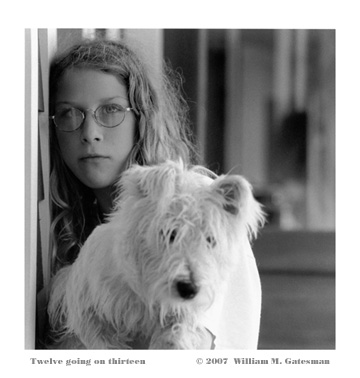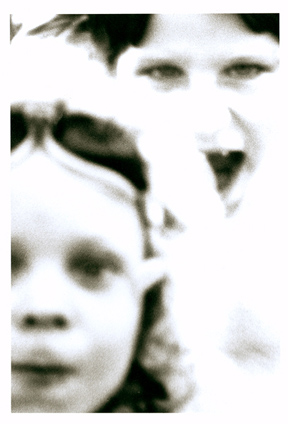July 3, 2008

_________________________________
Light always plays a part to a greater or lesser degree in any photograph. Sometimes, as was the case the morning of June 30 when I captured the image in this post, light becomes a compositional element in the photograph.
But light can be a fickle subject. She is prone to fool your lightmeter, claiming for herself center stage, causing your camera to underexpose your main subject.
Light also can be elusive. While she is eager to show herself in all her glory, she will do so for but a moment. The photographer must act quickly to capture her on film before she slips away to hide in the full glare of the sun.
A photographer will be well served to learn the secrets of natural light.
May 13, 2008
I am hopeful that my photographs strike an emotional chord thereby enabling the viewer, if just for a moment, to step out of his or her limited sense of self. I was reminded of this phenomenon this past weekend.
A friend and I have just returned from our annual pilgrimage to the Bach festival in Bethlehem, PA. Discussing the generally recognized sacred nature of Bach’s music and our own individual thoughts and experiences in listening to the live performances, the following idea arose: Read the rest…
November 9, 2007

Daniel Oppenheimer, in writing about the photographer, Diane Arbus, states that her “brilliance was to catch everybody unmasked, at the moment of transition between unconscious repose and practiced, social self-representation. People seemed to reveal, in that moment, their essential being . . .”
My objective in making photographic portraits is to do the same thing, although more often than not it happens by chance when I simply am taking someone’s picture. I think I have been successful in capturing my subject in that “moment of transition” in the photograph, Twelve going on thirteen.
I think that such “moment of transition” as it is represented in this photograph is a good metaphor for a budding young woman’s emotional state as she transitions from the state of being a child to the state of being a teenager. I invite you to consider also whether the background in the photograph contributes to that sense of meaning.
Twelve going on thirteen is featured in the Portraits gallery at www.wmgphoto.com
David Oppenheimer’s biography of Diane Arbus is located — Here —
November 1, 2007
Paul Indigo, in his blog Beyond the Obvious has stated that: “If you look at the great masters of photography and their images, many of which have become iconic, you see that there is a distinct gap between text book perfection and what they’ve produced. Most great pictures that touch our hearts have technical flaws. . . . But it doesn’t matter because there’s so much emotion and power in their images.”
 The image in this post, Boys at Play, is a scan of a black and white photograph I created in a traditional wet darkroom. The negative for this image contains much more visual information than the print, however I used an Ilford Mutigrade filter on my enlarger which had the effect of creating the more posterized image you see here. I suppose one might be able to create a similar effect using the posterize feature in photoshop, but I don’t know if that would yield the same result with this image as I obtained using traditional photo processing techniques.
The image in this post, Boys at Play, is a scan of a black and white photograph I created in a traditional wet darkroom. The negative for this image contains much more visual information than the print, however I used an Ilford Mutigrade filter on my enlarger which had the effect of creating the more posterized image you see here. I suppose one might be able to create a similar effect using the posterize feature in photoshop, but I don’t know if that would yield the same result with this image as I obtained using traditional photo processing techniques.
Given the posterized nature of this picture, one might argue that it is not a technically perfect representation of the subject. Nevertheless, for me, it is an effective photograph because, without fail, I have an intense emotional reaction every time I view Boys at Play.
The same can be said about “Robert Capa’s shots of the Normandy landing”, to give but one of the examples pointed out by Paul Indigo. Capa’s photograph of a soldier wading in the ocean towards the shore is blurry and grainy and by no means a technically perfect image, but it is one to which I have a strong emotional response. For me, this photograph successfully captures what it must have been like to be that soldier in that circumstance.
With Boys at Play my response is something akin to dread. But, being the father of two sons, I know that boys (and their dads) often engage in rough play, play that to an outside observer may appear to be something more sinister. I believe that Boys at Play is a successful image insofar as it captures the sinister-looking nature of the interaction between two boys.
You may view a larger version of Boys at Play by logging on to the Surreal Portraits Gallery at my online Photo Gallery at www.wmgphoto.com by clicking –here–
To view Paul Indigo’s blog post Great images may be techically flawed, click –here–
Robert Capa’s most famous Normandy landing photograph can be viewed –here–
________________________________________
Paul Indigo comments:
“Interesting article and I appreciate the way you share your personal feelings about Boys at Play. The emotion in the image hits you straight away and photography is after all about communication, not slavishly following a set of dogmatic rules. I suppose the idea that you and I are trying to get across can be summed up in a simple question: ‘Do you want to be the best rule follower in the world or the best visual communicator?'”
October 6, 2007
A recent correspondent, after looking at the photos in the Gatesman Photo Gallery, observed that telling our individual experiences through the process of “doing art” is a way in which we may connect to the universe. It is this ability, the correspondent suggests, that makes us humans and not just animals. Read the rest…




